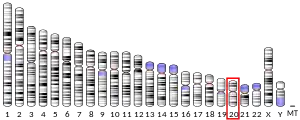| CST4 | |||||||||||||||||||||||||||||||||||||||||||||||||||
|---|---|---|---|---|---|---|---|---|---|---|---|---|---|---|---|---|---|---|---|---|---|---|---|---|---|---|---|---|---|---|---|---|---|---|---|---|---|---|---|---|---|---|---|---|---|---|---|---|---|---|---|
| Identifiers | |||||||||||||||||||||||||||||||||||||||||||||||||||
| Aliases | CST4, cystatin S | ||||||||||||||||||||||||||||||||||||||||||||||||||
| External IDs | OMIM: 123857 GeneCards: CST4 | ||||||||||||||||||||||||||||||||||||||||||||||||||
| |||||||||||||||||||||||||||||||||||||||||||||||||||
| |||||||||||||||||||||||||||||||||||||||||||||||||||
| |||||||||||||||||||||||||||||||||||||||||||||||||||
| |||||||||||||||||||||||||||||||||||||||||||||||||||
| Wikidata | |||||||||||||||||||||||||||||||||||||||||||||||||||
| |||||||||||||||||||||||||||||||||||||||||||||||||||
Cystatin-S is a protein that in humans is encoded by the CST4 gene.[3][4]
The cystatin superfamily encompasses proteins that contain multiple cystatin-like sequences. Some of the members are active cysteine protease inhibitors, while others have lost or perhaps never acquired this inhibitory activity. There are three inhibitory families in the superfamily, including the type 1 cystatins (stefins), type 2 cystatins and the kininogens. The type 2 cystatin proteins are a class of cysteine proteinase inhibitors found in a variety of human fluids and secretions. The cystatin locus on chromosome 20 contains the majority of the type 2 cystatin genes and pseudogenes. This gene is located in the cystatin locus and encodes a type 2 salivary cysteine peptidase inhibitor. The protein is an S-type cystatin, based on its high level of expression in saliva, tears and seminal plasma. The specific role in these fluids is unclear but antibacterial and antiviral activity is present, consistent with a protective function.[4]
References
- 1 2 3 GRCh38: Ensembl release 89: ENSG00000101441 - Ensembl, May 2017
- ↑ "Human PubMed Reference:". National Center for Biotechnology Information, U.S. National Library of Medicine.
- ↑ Saitoh E, Isemura S, Sanada K, Ohnishi K (Apr 1992). "The human cystatin gene family: cloning of three members and evolutionary relationship between cystatins and Bowman-Birk type proteinase inhibitors". Biomed Biochim Acta. 50 (4–6): 599–605. PMID 1801729.
- 1 2 "Entrez Gene: CST4 cystatin S".
External links
- The MEROPS online database for peptidases and their inhibitors: I25.008
- Human CST4 genome location and CST4 gene details page in the UCSC Genome Browser.
Further reading
- Brown WM, Dziegielewska KM (1997). "Friends and relations of the cystatin superfamily--new members and their evolution". Protein Sci. 6 (1): 5–12. doi:10.1002/pro.5560060102. PMC 2143511. PMID 9007972.
- Saitoh E, Isemura S, Sanada K, Ohnishi K (1993). "Characterization of Two Members(CST4 and CST5) of the Cystatin Gene Family and Molecular Evolution of Cystatin Genes". Recent Progress on Kinins. Vol. 38. pp. 340–8. doi:10.1007/978-3-0348-7321-5_43. ISBN 978-3-0348-7323-9. PMID 1334620.
{{cite book}}:|journal=ignored (help) - Takahashi M, Honda Y, Ogawa K, Barka T (1993). "Immunofluorescence localization of cystatins in human lacrimal gland and in the exorbital lacrimal gland of the rat". Acta Ophthalmologica. 70 (5): 625–31. doi:10.1111/j.1755-3768.1992.tb02143.x. PMID 1471486. S2CID 30180390.
- Johnsson M, Richardson CF, Bergey EJ, et al. (1992). "The effects of human salivary cystatins and statherin on hydroxyapatite crystallization". Arch. Oral Biol. 36 (9): 631–6. doi:10.1016/0003-9969(91)90014-L. PMID 1741693.
- Ramasubbu N, Reddy MS, Bergey EJ, et al. (1992). "Large-scale purification and characterization of the major phosphoproteins and mucins of human submandibular-sublingual saliva". Biochem. J. 280 (2): 341–52. doi:10.1042/bj2800341. PMC 1130552. PMID 1747107.
- Isemura S, Saitoh E, Sanada K, Minakata K (1992). "Identification of full-sized forms of salivary (S-type) cystatins (cystatin SN, cystatin SA, cystatin S, and two phosphorylated forms of cystatin S) in human whole saliva and determination of phosphorylation sites of cystatin S". J. Biochem. 110 (4): 648–54. doi:10.1093/oxfordjournals.jbchem.a123634. PMID 1778989.
- Lamkin MS, Jensen JL, Setayesh MR, et al. (1991). "Salivary cystatin SA-III, a potential precursor of the acquired enamel pellicle, is phosphorylated at both its amino- and carboxyl-terminal regions". Arch. Biochem. Biophys. 288 (2): 664–70. doi:10.1016/0003-9861(91)90249-I. PMID 1898055.
- Bobek LA, Aguirre A, Levine MJ (1991). "Human salivary cystatin S. Cloning, sequence analysis, hybridization in situ and immunocytochemistry". Biochem. J. 278 (3): 627–35. doi:10.1042/bj2780627. PMC 1151393. PMID 1898352.
- Freije JP, Abrahamson M, Olafsson I, et al. (1991). "Structure and expression of the gene encoding cystatin D, a novel human cysteine proteinase inhibitor". J. Biol. Chem. 266 (30): 20538–43. doi:10.1016/S0021-9258(18)54958-9. PMID 1939105.
- Saitoh E, Isemura S, Sanada K, et al. (1989). "Cystatin superfamily. Evidence that family II cystatin genes are evolutionarily related to family III cystatin genes". Biol. Chem. Hoppe-Seyler. 369 Suppl: 191–7. PMID 3202964.
- Hawke DH, Yuan PM, Wilson KJ, Hunkapiller MW (1987). "Identification of a long form of cystatin from human saliva by rapid microbore HPLC mapping". Biochem. Biophys. Res. Commun. 145 (3): 1248–53. doi:10.1016/0006-291X(87)91571-3. PMID 3496880.
- Isemura S, Saitoh E, Ito S, et al. (1985). "Cystatin S: a cysteine proteinase inhibitor of human saliva". J. Biochem. 96 (4): 1311–4. doi:10.1093/oxfordjournals.jbchem.a134952. PMID 6394600.
- Isemura S, Saitoh E, Sanada K (1985). "Isolation and amino acid sequence of SAP-1, an acidic protein of human whole saliva, and sequence homology with human gamma-trace". J. Biochem. 96 (2): 489–98. doi:10.1093/oxfordjournals.jbchem.a134861. PMID 6501254.
- Dickinson DP, Thiesse M, Dempsey LD, Millar SJ (1993). "Genomic cloning, physical mapping, and expression of human type 2 cystatin genes". Crit. Rev. Oral Biol. Med. 4 (3–4): 573–80. doi:10.1177/10454411930040034401. PMID 7690606.
- Dickinson DP, Zhao Y, Thiesse M, Siciliano MJ (1995). "Direct mapping of seven genes encoding human type 2 cystatins to a single site located at 20p11.2". Genomics. 24 (1): 172–5. doi:10.1006/geno.1994.1595. PMID 7896273.
- Thiesse M, Millar SJ, Dickinson DP (1994). "The human type 2 cystatin gene family consists of eight to nine members, with at least seven genes clustered at a single locus on human chromosome 20". DNA Cell Biol. 13 (2): 97–116. doi:10.1089/dna.1994.13.97. PMID 8179826.
- Henskens YM, van den Keijbus PA, Veerman EC, et al. (1996). "Protein composition of whole and parotid saliva in healthy and periodontitis subjects. Determination of cystatins, albumin, amylase and IgA". Journal of Periodontal Research. 31 (1): 57–65. doi:10.1111/j.1600-0765.1996.tb00464.x. PMID 8636877.
- Baron A, DeCarlo A, Featherstone J (2000). "Functional aspects of the human salivary cystatins in the oral environment". Oral Diseases. 5 (3): 234–40. doi:10.1111/j.1601-0825.1999.tb00307.x. PMID 10483070.

